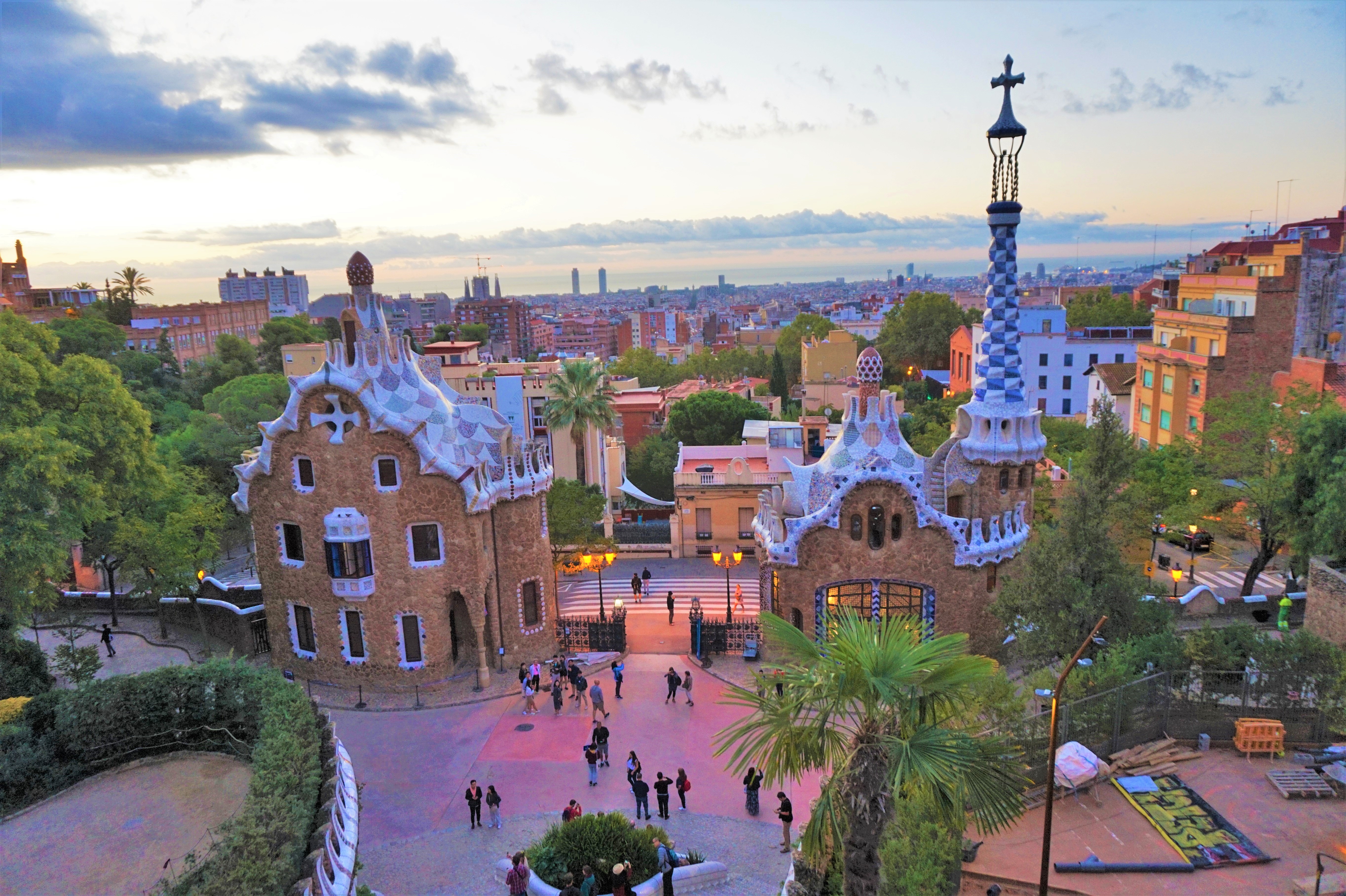[SPAIN] Barcelona - A Complete Guide to Park Güell

Nestled among Carmel Hill’s north face, Park Güell is another masterpiece by Gaudí which offers sweeping panoramic vistas of Barcelona city below. This impressive park covers a total of 12 hectares. A giant salamander known as “the dragon” greets visitors at the staircase near the main entrance as visitors approaching the terrace. It has become a symbol of Barcelona along with Sagrada La Familia.
Getting there:
Metro: green line (L3), Lesseps or Vallcarca stationsBus: No. 24, H6, D40 lines
Bus Turístic and Barcelona City Tour: From the Bus Turístic (blue line) the stop is "Park Güell". From the Barcelona City Tour, the route is "East" (green color) and the stop is also "Park Güell".
Park Güell has three entrances: one on Carrer de Larrard (main entrance as seen above), one at Carretera del Carmel, nº 23, where there is also the coach parking for tourist coaches, and a third on Passatge de Sant Josep de la Muntanya, which you get to by going up an escalator. The walk from the two metro stations takes about 15-20 minutes. You can take the escalator uphill to reach the main entrance.

I chose to take bus No.24 to Ramiro de Maeztu C N Catalunya which is about 12 stops (18 min) from Pg. de Gracia Diagonal stop. From the bust stop above the park, I just walked downhill all the way to reach the Monumental Zone.
How to enter Park Güell for free:
Most of the park is free to get into, except for the Monumental Zone (the zone marked in yellow), where you need to have a timed ticket. There are several ways to enter the Monumental Zone of Parc Güell for free.

Unofficially, you can enter the Monumental Zone for free before the access controls are put in place or after they are removed at night. In the morning, the access controls are usually put in place half an hour before the opening hours (8am – 8.30am) and are removed at the closing time. If you enter during the free time, you are not required to leave when ticketing begins, and you can depart at your leisure.
Officially, you can enter the park for free at selected time and dates.
1) During winter (November 1st-March 30th), on the first Sunday of every month, a limited number of free tickets are given out at the box office while supplies last.
2) During summer (April 1st- October 31st). Every Sunday from 17:00 to 20:00 hours.
3) Open house on April 23rd for Sant Jordi holiday, May 18th and September 24th for La Mercè.
This is the free zone of the park. Colonnaded pathway resembles the pine trees in the park. They were built with stones quarried within the park. Bird nests have been installed in the walkways.
Best time to enter the park:
Early morning is the best if you want to avoid the tourist onslaught arrives. I was there before the sun rises, there was already a small crowd at the Monumental Zone. It is quieter at night, but you won’t get to see the park in its full glory since limited lighting is provided at night.
What you need to know before buying ticket:
Access to the Monumental Zone of Park Güell is limited to 400 people every 30 minutes. Tickets are available at the box office or online. Tickets are assigned on the basis of time-slots, and you can enter the Monumental Zone up to 30 minutes after your allocated start time. You can stay as long as you like after you enter. Once tickets have been purchased, no change of date or time will be allowed. The tickets for visiting the Monumental Zone do not include the Gaudí House Museum.
I highly recommend to book online. You’ll get to save time as you might have to wait to get a free time period if you buy the tickets at the box office.
Historic background on Park Güell:
In 1890 Güell instructed the architect Antoni Gaudí to build a garden city. Güell wanted to recreate the British residential parks and locate homes close to nature. When work began in 1900, despite its clean and green environment, Park Güell was considered too far away from the core of Barcelona and the wealthy preferred to live near Passeig de Gracia. It was not successful as a housing development; only two of the envisioned 60 houses were built.
For many years the Güell family lived in Casa Larrard (now a school) that stood on the land where the development was located. Gaudí bought the model house, one of the two houses that were built there. He lived here with his family until he died in 1926. Güell sold the park to the City Council which opened it to the city as a public park in 1926. In 1963, Gaudí’s former home is converted into a museum. It is easily distinguished by its pink exterior rising four stories tall from the garden grounds (see photo above). Park Güell has been a World Heritage site since 1984, along with other works by the architect Antoni Gaudí.
Places in Park Güell
1) The Greek Theater or Nature Square
This is the main terrace of the park which is a viewpoint over the city. It was planned for staging large open-air shows. It was packed with people and I had to wait in turn to take a photo on the bench.


This main terrace is surrounded by a long bench in the form of sea serpent. The curves of the bench form a number of enclaves.
2) Hypostyle Hall
Under the Nature Square is the Hypostyle Hall with tall columns supporting the roof. It was designed to house the weekly market. The ceiling is formed of small domes, decorated with tile-shard mosaics.
3) Dragon Stairways
The Dragon Stairways provides access to the park's central features.The twin flight of steps, flanked by two walls with merlons, is divided into three sections. Halfway up the steps is the emblem of Catalonia and further up the dragon or salamander, covered with decorative tile-shard mosaic. The last flight of steps is sheltered under the hypostyle hall.
There are two grotto besides the staircase. The one on the right was used as waiting shelter.
4) The entrance and lodge pavillion

The porter's lodge to the right of the main entrance is currently part of Barcelona History Museum, with the exhibition "Güell, Gaudi and Barcelona, the expression of an urban ideal". It looks like a giant ginger bread house.
5) Austria Garden
The Austria Gardens were originally reserved for a house within the complex, but first was home to a kitchen garden and later became a municipal nursery. They were known as the Austria Gardens because they were planted with species from this country.
A visit to Park Güell is a must while in Barcelona. If you have time, consider visiting Casa Vicens which is nearby the park.
It was the first house designed by Gaudi.





































![[MALAYSIA] How To Do A Self Guided Walking Tour in Kota Kinabalu](https://blogger.googleusercontent.com/img/b/R29vZ2xl/AVvXsEgR_cJjX4Shl9rsz0ufzxjmtLMq5PAvmTNDHypSVV2CYDaarZVj8EMznRkXqdVeCGg2yEMdFqPtI5rvrmMtJVSL1W9jqOtdCM2EFAc5ZTWn7XzPQV5sqS4s1DO0T_AuF0nq_dLQ53b9-ju3yyLJUrvU2TlhbmD4rDDV5-aPFaT2WEQZ1c257JXGUhyfsw/s72-c/20220524_131141.jpg)
![[FRANCE] My Favourite Paris Eiffel Tower Photo Spots](https://blogger.googleusercontent.com/img/b/R29vZ2xl/AVvXsEi220KHLfBDpyO53KorHwAb0KQEuiiaVDlrFYwEEAvs8YvKb-Edmyt7Hl7rZszN6qc-GM4e3SmjBS2pUiCiv8ljl8mnrUR93Ljxb0xGrSZ4sZLPRErpbAj29btKvnIC67xV93iKnrH3QRcc/s72-w781-c-h505/DSCF4372.JPG)
![[JAPAN] Osaka Universal Studio](https://blogger.googleusercontent.com/img/b/R29vZ2xl/AVvXsEilW88BKY24KkvC4WjRfTktmxFmylxMsDD8emYT93x8bOlgqzMV1feAp28Si_GPn3hyFD2E97CMmP3X6kceDfFa9WB_7qr2BFvmu20iVJRaNlZd1BfoyUUj5ZgofOgK5lZGoqVDS4-1YLTo/s72-c/?imgmax=800)


![[MONACO] How To Visit Monaco In One Day From Nice](https://blogger.googleusercontent.com/img/b/R29vZ2xl/AVvXsEgZkJeVAOmz4LTRwY2uDTK131UJVUWH_44GUUU3H-ni63dK2BlNqITBIh5Tdcpz9kXTUb7ePW7f-PQ1Y7E6B4lnqKEHs_nL3Eop-ouoFhxayMI4lNCcUG-oJnGMVwpGDlBu8lfgn10H_QHw/s72-c/DSC06605.JPG)

![[MOROCCO] My Day Trip to Blue City of Chefchaouen From Fez](https://blogger.googleusercontent.com/img/b/R29vZ2xl/AVvXsEh-7PIqgkIbF1BtTIOwfZ2R611OUrvV7f4Uxih57is62V_QD_DySCdifgR250MMruySrRmV7UMQ14iRsQZ6ifAaAWTqYacWSu__Lpm6QuqEjUcMZ4IJz-0SLDKeCV-nn6Zk1qbyMtMaZf4YupMArl4gXmmXoQUxHc6T-_eW-X2jvjh47rlu4Ddq4_Q48g/s72-c/DSC07946.JPG)
0 comments: